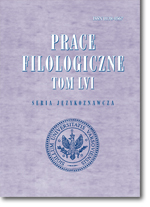Formy fleksyjne rzeczowników w wybranych zabytkach szesnastowiecznych a paradygmaty współczesne
Noun Inflectional Forms in Selected 16th Century Old Prints as Contrasted with Contemporary Paradigms
Author(s): Alina KępińskaSubject(s): Language and Literature Studies
Published by: Wydział Polonistyki Uniwersytetu Warszawskiego
Keywords: ewolucja języka; przypadek gramatyczny; fleksja; morfologia, analogia. Language evolution; grammatical case; inflection; morphology analogy
Summary/Abstract: The paper deals with noun endings which differ from the contemporary ones and were found in three 16th century old prints. Their study enables to show changes in the sub-inflectional system and the directions of pronominal inflection evolution. All the recorded changes of morphological exponents are syntactically motivated: they include either the isofunctional endings or the endings of words having the exact position in parallel constructions or – as in the case of the {-ej- ending – take place in a homogenous syntactic unit, such as a phrase. The examined texts contain nouns having endings which are either obsolete such as sing. masc. gen. {-e} and {-ej}, pl. fem. acc. {-ą}, pl. instr. {-y}, pl. loc. {-ech} and {-och} or changed the range of their use, as in the following endings: pl. masc. nom. {-owie} and {-i} // {-y}.
Journal: Prace Filologiczne
- Issue Year: 2009
- Issue No: 56
- Page Range: 175-196
- Page Count: 22
- Language: Polish

